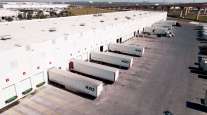E-Commerce Powers UPS to 23% Rise in 4Q Profit

UPS Inc. raised fourth-quarter net income on an adjusted basis by 23% to $1.41 billion, or $1.57 per share, as a transition toward e-commerce package deliveries to consumers accelerated during the 2015 peak holiday shipping season.
Profit before interest and taxes was 17% higher at $2.17 billion, also excluding adjustments in the 2015 and 2014 periods.
The Atlanta-based company’s revenue rose 1% to $16.1 billion.
“The explosive growth of e-commerce continues to create great opportunities,” said David Abney, CEO of UPS, which ranks No. 1 on the Transport Topics Top 100 list of for-hire carriers in the United States and Canada.
His statement reflected UPS deliveries of 612 million packages during the peak season. Deliveries to consumers rose twice as fast as business-to-business packages as UPS made deliveries to 1.9 million new addresses in the quarter.
Deliveries increased 2.4%, although direct-labor hours fell 1%, UPS reported, with help from technology that allowed drivers to make deliveries of package and Sure Post shipments in a single stop during the peak period.
Sure Post is an economy and residential ground service.
The fourth-quarter results were a turnaround from 2014, when UPS acknowledged excessive costs to hire too many workers for the holiday peak season. That move was an effort to correct 2013, when UPS had higher costs as well as some delayed holiday season deliveries.
“UPS was able to manage through this volatile and challenging period better than in the past due mainly, in our view, to greater network capacity, improved customer management and better labor management,” said a report from David Ross, a Stifel, Nicolaus & Co. analyst.
UPS officials attributed part of the 2015 improvement to the July acquisition of broker Coyote Logistics, which provided purchased capacity when needed to improve overall productivity.
Abney also detailed the transition to a more consumer-driven business model by noting that UPS results have moved away from a tight correlation with industrial production statistics that were in place five years ago, when the company’s business-to-business shipments predominated.
Domestic revenue was 2.6% higher at $10.3 billion, held down by lower fuel surcharge collections. Package profit before interest and taxes rose 18% to $1.35 billion.
On the international side, profits rose 16%, helped by operational improvements, a strong performance in Europe and enhanced pricing. The international unit’s profits were the best ever for any quarter, Abney said. Revenue in that segment fell 7.3% to $3.18 billion, including a 3.5 percentage-point decline that was attributed to lower fuel surcharges.
Logistics’ unit revenue growth from the Coyote acquisition offset softer freight markets and reduced fuel surcharge revenue, the company said. Airfreight and freight forwarding results also improved at the unit, whose revenue rose 6% to $2.61 billion, generating an 11% rise in profitability.
Results worsened at UPS Freight. Revenue fell 12.2% to $679 million, with about half of the decline due to lower fuel surcharges. Shipments declined 9.7%. UPS doesn’t disclose profits for each segment of the supply chain and freight unit.
Myron Gray, president of U.S. Operations, noted that less-than-truckload markets have been softening for all carriers since the fourth quarter of 2014 as industrial production slumped. He also said there was no sign of rate cutting by other carriers.
Including gains and charges in both periods, earnings nearly tripled to $1.33 billion, or $1.48, from $453 million, or 49 cents. In the 2015 quarter, those adjustments included a pension accounting charge of $79 million. In the 2014 quarter, pension accounting and retirement cost changes for some workers lowered net income by $692 million.
For 2016, the company forecast growth in earnings per share of 5% to 9% over 2015’s $5.35 on an adjusted basis, despite domestic and global economic uncertainty. Abney said expected strength in consumer demand, primarily during the second half, would drive 2016 results.
Domestic package volume could increase 4%, with 6% higher revenue and profit growth of as much as 9%. In the international sector, profit growth for the year could reach as high as 12%.
Profit improvement was pegged at about 7% in the supply chain and freight business, with revenue growth of 15% or more helped by the Coyote acquisition.
Abney said he didn’t believe Amazon’s efforts to expand its own logistics and transportation services would have any substantial effect on UPS because of the value provided by his company’s extensive network.




